All the solutions provided in McGraw Hill My Math Grade 4 Answer Key PDF Chapter 8 Lesson 7 Use Benchmark Fractions to Compare and Order will give you a clear idea of the concepts.
McGraw-Hill My Math Grade 4 Answer Key Chapter 8 Lesson 7 Use Benchmark Fractions to Compare and Order
Benchmark fractions are common fractions, such as \(\frac{1}{2}\), that are often used to compare and order fractions.
Math in My World
Example 1
A recipe for granola uses \(\frac{5}{8}\)-cup of raisins and \(\frac{1}{6}\)-cup of dried cranberries, Is there a greater amount of raisins or cranberries?

Compare \(\frac{5}{8}\) and \(\frac{1}{6}\).
1. Use \(\frac{1}{2}\) as a benchmark fraction.
You know that \(\frac{1}{2}\) is equivalent to \(\frac{4}{8}\) and \(\frac{3}{6}\).
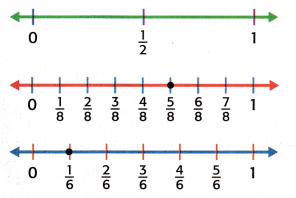
2. Compare. \(\frac{5}{8}\) > \(\frac{1}{2}\) and \(\frac{1}{6}\) < \(\frac{1}{2}\).
So, \(\frac{5}{8}\) ![]() \(\frac{1}{6}\).
\(\frac{1}{6}\).
There is a greater amount of _______________ in the granola recipe.
Answer:
\(\frac{5}{8}\) is greater than \(\frac{1}{6}\).
There is a greater amount of cups of raisins in the granola recipe.
Explanation:
Number of cups of raisins granola uses for recipe = \(\frac{5}{8}\)
Number of cup of dried cranberries = \(\frac{1}{6}\)
Is there a greater amount of raisins or cranberries
\(\frac{1}{2}\) as a benchmark fraction.
Equivalent fractions of \(\frac{1}{2}\):
\(\frac{1}{2}\) = \(\frac{1}{2}\) × \(\frac{4}{4}\) = \(\frac{4}{8}\) \(\frac{1}{2}\) = \(\frac{1}{2}\) × \(\frac{3}{3}\) =\(\frac{3}{6}\).

\(\frac{5}{8}\) > \(\frac{1}{2}\)
\(\frac{1}{6}\) < \(\frac{1}{2}\)
So, \(\frac{5}{8}\) > \(\frac{1}{6}\).
Example 2
List \(\frac{7}{8}\), \(\frac{1}{2}\), and \(\frac{1}{3}\) in order from least to greatest.

1. Use \(\frac{1}{2}\) as a benchmark fraction.
You know that \(\frac{1}{2}\) is equivalent to \(\frac{4}{8}\) and \(\frac{3}{6}\).
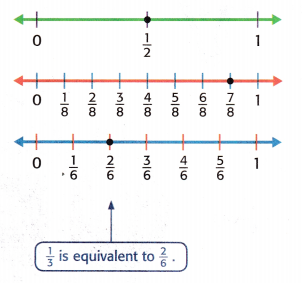
2. Compare. \(\frac{7}{8}\) > \(\frac{1}{2}\) and \(\frac{1}{3}\) < \(\frac{1}{2}\).
So, from least to greatest, the fractions are \(\frac{1}{3}\), \(\frac{1}{2}\), \(\frac{7}{8}\).

Answer:
Least to greatest, the fractions are \(\frac{1}{3}\), \(\frac{1}{2}\), \(\frac{7}{8}\).
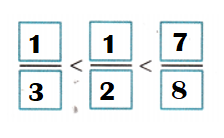
Explanation:
\(\frac{1}{2}\) as a benchmark fraction.
=> Equivalent fractions of \(\frac{1}{2}\):
\(\frac{1}{2}\) = \(\frac{1}{2}\) × \(\frac{4}{4}\) = \(\frac{4}{8}\) \(\frac{1}{2}\) = \(\frac{1}{2}\) × \(\frac{3}{3}\) =\(\frac{3}{6}\).

\(\frac{7}{8}\) > \(\frac{1}{2}\)
\(\frac{1}{3}\) < \(\frac{1}{2}\).
=> Least to greatest, the fractions are \(\frac{1}{3}\), \(\frac{1}{2}\), \(\frac{7}{8}\).
Talk Math
Explain how you know \(\frac{1}{8}\) < \(\frac{1}{2}\).
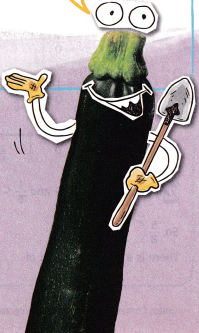
Answer:
\(\frac{1}{8}\) is lesser than \(\frac{1}{2}\).
Explanation:
\(\frac{1}{8}\): Out of whole eight parts only one part is shaded. = 0.125.
\(\frac{1}{2}\): Out of whole two parts only one part is shaded. = 0.5.
\(\frac{1}{8}\) < \(\frac{1}{2}\).
Guided Practice
Use a benchmark fraction to compare. Write >, <, or =.
Question 1.
\(\frac{3}{4}\) ![]() \(\frac{1}{2}\)
\(\frac{1}{2}\)
Answer:
\(\frac{3}{4}\) is greater than \(\frac{1}{2}\).
Explanation:
\(\frac{1}{2}\) as a benchmark fraction.
=> Equivalent fractions of \(\frac{1}{2}\):
\(\frac{1}{2}\) = \(\frac{1}{2}\) × \(\frac{4}{4}\) = \(\frac{4}{8}\) \(\frac{1}{2}\) = \(\frac{1}{2}\) × \(\frac{3}{3}\) =\(\frac{3}{6}\).
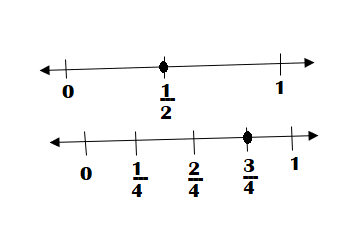
\(\frac{3}{4}\) > \(\frac{1}{2}\)
Question 2.
\(\frac{3}{6}\) ![]() \(\frac{3}{4}\)
\(\frac{3}{4}\)
Answer:
\(\frac{3}{6}\) is lesser than \(\frac{3}{4}\).
Explanation:
\(\frac{1}{2}\) as a benchmark fraction.
=> Equivalent fractions of \(\frac{1}{2}\):
\(\frac{1}{2}\) = \(\frac{1}{2}\) × \(\frac{4}{4}\) = \(\frac{4}{8}\) \(\frac{1}{2}\) = \(\frac{1}{2}\) × \(\frac{3}{3}\) =\(\frac{3}{6}\).

\(\frac{3}{6}\) is equivalent to \(\frac{1}{2}\).
\(\frac{3}{6}\) < \(\frac{3}{4}\)
Independent Practice
Use a benchmark fraction to compare. Write >, <, or =.
Question 3.
\(\frac{4}{5}\) ![]() \(\frac{1}{3}\)
\(\frac{1}{3}\)
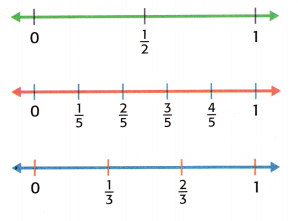
Answer:
\(\frac{4}{5}\) is greater than \(\frac{1}{3}\).
Explanation:
\(\frac{1}{2}\) as a benchmark fraction.
=> Equivalent fractions of \(\frac{1}{2}\):
\(\frac{1}{2}\) = \(\frac{1}{2}\) × \(\frac{4}{4}\) = \(\frac{4}{8}\) \(\frac{1}{2}\) = \(\frac{1}{2}\) × \(\frac{3}{3}\) =\(\frac{3}{6}\).
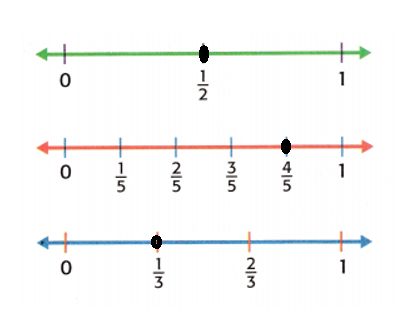
\(\frac{4}{5}\) > \(\frac{1}{3}\)
Question 4.
\(\frac{1}{2}\) ![]() \(\frac{3}{5}\)
\(\frac{3}{5}\)
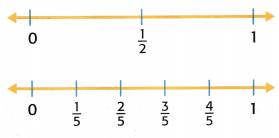
Answer:
\(\frac{1}{2}\) is lesser than \(\frac{3}{5}\).
Explanation:
\(\frac{1}{2}\) as a benchmark fraction.
=> Equivalent fractions of \(\frac{1}{2}\):
\(\frac{1}{2}\) = \(\frac{1}{2}\) × \(\frac{4}{4}\) = \(\frac{4}{8}\) \(\frac{1}{2}\) = \(\frac{1}{2}\) × \(\frac{3}{3}\) =\(\frac{3}{6}\).
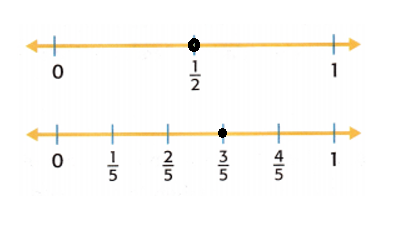
\(\frac{1}{2}\) < \(\frac{3}{5}\)
Question 5.
\(\frac{1}{3}\) ![]() \(\frac{8}{10}\)
\(\frac{8}{10}\)
Answer:
\(\frac{1}{3}\) is lesser than \(\frac{8}{10}\).
Explanation:
\(\frac{1}{2}\) as a benchmark fraction.
=> Equivalent fractions of \(\frac{1}{2}\):
\(\frac{1}{2}\) = \(\frac{1}{2}\) × \(\frac{4}{4}\) = \(\frac{4}{8}\) \(\frac{1}{2}\) = \(\frac{1}{2}\) × \(\frac{3}{3}\) =\(\frac{3}{6}\).
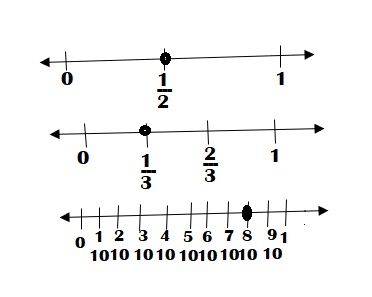
\(\frac{1}{3}\) < \(\frac{8}{10}\)
Question 6.
\(\frac{2}{3}\) ![]() \(\frac{1}{6}\)
\(\frac{1}{6}\)
Answer:
\(\frac{2}{3}\) is greater than \(\frac{1}{6}\).
Explanation:
\(\frac{1}{2}\) as a benchmark fraction.
=> Equivalent fractions of \(\frac{1}{2}\):
\(\frac{1}{2}\) = \(\frac{1}{2}\) × \(\frac{4}{4}\) = \(\frac{4}{8}\) \(\frac{1}{2}\) = \(\frac{1}{2}\) × \(\frac{3}{3}\) =\(\frac{3}{6}\).
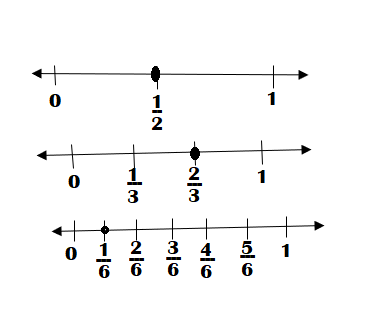
\(\frac{2}{3}\) > \(\frac{1}{6}\)
Question 7.
\(\frac{3}{4}\) ![]() \(\frac{2}{5}\)
\(\frac{2}{5}\)
Answer:
\(\frac{3}{4}\) is greater than \(\frac{2}{5}\).
Explanation:
\(\frac{1}{2}\) as a benchmark fraction.
=> Equivalent fractions of \(\frac{1}{2}\):
\(\frac{1}{2}\) = \(\frac{1}{2}\) × \(\frac{4}{4}\) = \(\frac{4}{8}\) \(\frac{1}{2}\) = \(\frac{1}{2}\) × \(\frac{3}{3}\) =\(\frac{3}{6}\).
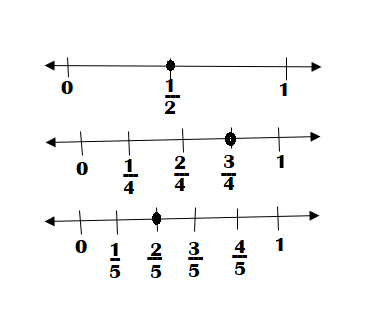
\(\frac{3}{4}\) > \(\frac{2}{5}\)
Question 8.
\(\frac{1}{4}\) ![]() \(\frac{4}{5}\)
\(\frac{4}{5}\)
Answer:
\(\frac{1}{4}\) is lesser than \(\frac{4}{5}\).
Explanation:
\(\frac{1}{2}\) as a benchmark fraction.
=> Equivalent fractions of \(\frac{1}{2}\):
\(\frac{1}{2}\) = \(\frac{1}{2}\) × \(\frac{4}{4}\) = \(\frac{4}{8}\) \(\frac{1}{2}\) = \(\frac{1}{2}\) × \(\frac{3}{3}\) =\(\frac{3}{6}\).

\(\frac{1}{4}\) < \(\frac{4}{5}\)
Question 9.
\(\frac{1}{3}\) ![]() \(\frac{1}{8}\)
\(\frac{1}{8}\)
Answer:
\(\frac{1}{3}\) is greater than \(\frac{1}{8}\).
Explanation:
\(\frac{1}{2}\) as a benchmark fraction.
=> Equivalent fractions of \(\frac{1}{2}\):
\(\frac{1}{2}\) = \(\frac{1}{2}\) × \(\frac{4}{4}\) = \(\frac{4}{8}\) \(\frac{1}{2}\) = \(\frac{1}{2}\) × \(\frac{3}{3}\) =\(\frac{3}{6}\).
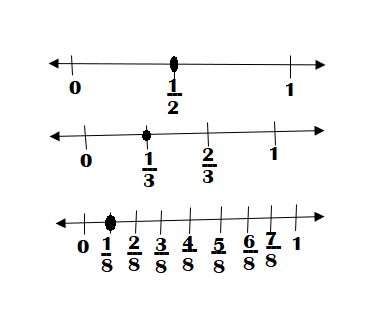
\(\frac{1}{3}\) > \(\frac{1}{8}\)
Question 10.
\(\frac{3}{6}\) ![]() \(\frac{2}{4}\)
\(\frac{2}{4}\)
Answer:
\(\frac{3}{6}\) is equal to \(\frac{2}{4}\).
Explanation:
\(\frac{1}{2}\) as a benchmark fraction.
=> Equivalent fractions of \(\frac{1}{2}\):
\(\frac{1}{2}\) = \(\frac{1}{2}\) × \(\frac{4}{4}\) = \(\frac{4}{8}\) \(\frac{1}{2}\) = \(\frac{1}{2}\) × \(\frac{3}{3}\) =\(\frac{3}{6}\).

\(\frac{3}{6}\) = \(\frac{2}{4}\)
Order from least to greatest.
Question 11.
\(\frac{1}{2}\), \(\frac{1}{8}\), \(\frac{3}{4}\)
Answer:
Order from least to greatest:
\(\frac{1}{8}\)
\(\frac{1}{2}\)
\(\frac{3}{4}\)
Explanation:
\(\frac{1}{2}\) as a benchmark fraction.
=> Equivalent fractions of \(\frac{1}{2}\):
\(\frac{1}{2}\) = \(\frac{1}{2}\) × \(\frac{4}{4}\) = \(\frac{4}{8}\) \(\frac{1}{2}\) = \(\frac{1}{2}\) × \(\frac{3}{3}\) =\(\frac{3}{6}\).
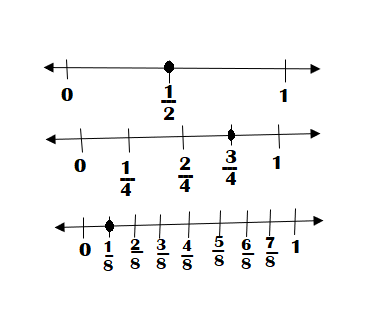
\(\frac{1}{8}\) < \(\frac{1}{2}\)
\(\frac{1}{2}\) < \(\frac{3}{4}\)
Question 12.
\(\frac{1}{2}\), \(\frac{3}{8}\), \(\frac{3}{5}\)
Answer:
Order from least to greatest:
\(\frac{3}{8}\)
\(\frac{1}{2}\)
\(\frac{3}{5}\)
Explanation:
\(\frac{1}{2}\) as a benchmark fraction.
=> Equivalent fractions of \(\frac{1}{2}\):
\(\frac{1}{2}\) = \(\frac{1}{2}\) × \(\frac{4}{4}\) = \(\frac{4}{8}\) \(\frac{1}{2}\) = \(\frac{1}{2}\) × \(\frac{3}{3}\) =\(\frac{3}{6}\).
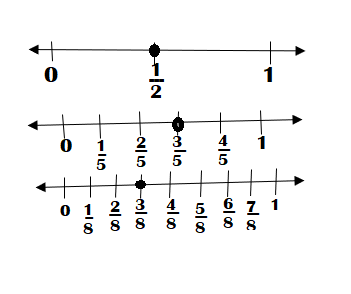
\(\frac{3}{8}\) < \(\frac{1}{2}\)
\(\frac{1}{2}\) < \(\frac{3}{5}\)
Question 13.
\(\frac{2}{3}\), \(\frac{1}{6}\), \(\frac{1}{2}\)
Answer:
Order from least to greatest:
\(\frac{1}{6}\)
\(\frac{1}{2}\)
\(\frac{2}{3}\)
Explanation:
\(\frac{1}{2}\) as a benchmark fraction.
=> Equivalent fractions of \(\frac{1}{2}\):
\(\frac{1}{2}\) = \(\frac{1}{2}\) × \(\frac{4}{4}\) = \(\frac{4}{8}\) \(\frac{1}{2}\) = \(\frac{1}{2}\) × \(\frac{3}{3}\) =\(\frac{3}{6}\).
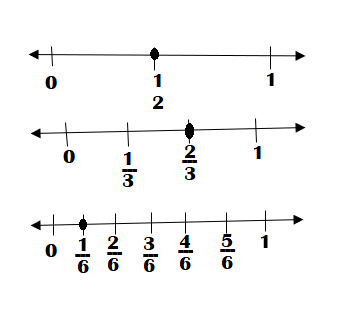
\(\frac{1}{6}\) < \(\frac{1}{2}\)
\(\frac{1}{2}\) < \(\frac{2}{3}\),
Problem Solving
Question 14.
A recipe calls for \(\frac{1}{2}\) teaspoon of salt and \(\frac{1}{4}\) teaspoon of baking soda. Which fraction is greater?
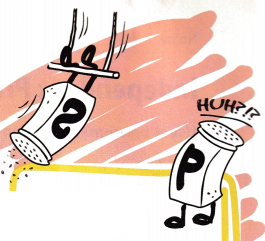
Answer:
\(\frac{1}{2}\) is greater than \(\frac{1}{4}\).
Explanation:
Number of teaspoons of salt a recipe calls = \(\frac{1}{2}\)
Number of teaspoons of baking soda = \(\frac{1}{4}\)
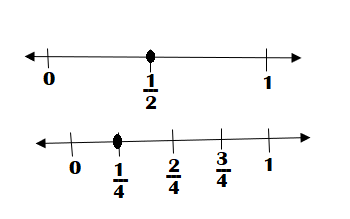
\(\frac{1}{4}\) < \(\frac{1}{2}\)
Question 15.
Sarah ran \(\frac{3}{4}\) mile on Saturday and \(\frac{1}{2}\) mile on Sunday. On which day did Sarah run farther?
Answer:
Saturday Sarah run farther.
Explanation:
Number of miles on Saturday Sarah ran = \(\frac{3}{4}\)
Number of miles on Sunday Sarah ran = \(\frac{1}{2}\)

\(\frac{3}{4}\) > \(\frac{1}{2}\)
Question 16.
A blanket is made up of \(\frac{7}{10}\) yard of red fabric and \(\frac{1}{3}\) yard of blue fabric. Is there more red fabric or blue fabric in the blanket?
Answer:
Red fabric is more than blue fabric in the blanket.
Explanation:
Number of yards of red fabric a blanket = \(\frac{7}{10}\)
Number of yards of blue fabric a blanket = \(\frac{1}{3}\)
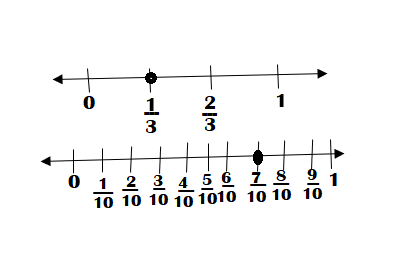
\(\frac{7}{10}\) > \(\frac{1}{3}\)
Question 17.
Mathematical PRACTICE Identify Structure One-sixth of a garden has tomatoes. One-half of the garden has peppers. One-third of the garden has onions. List the fractions in order from greatest to least.
Answer:
Fractions in order from greatest to least:
\(\frac{1}{2}\)
\(\frac{1}{3}\)
\(\frac{1}{6}\)
Explanation:
Portion of a garden has tomatoes = \(\frac{1}{6}\)
Portion of a garden has peppers = \(\frac{1}{2}\)
Portion of a garden has onions = \(\frac{1}{3}\)
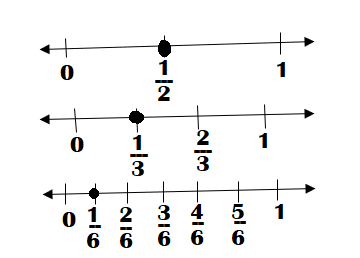
Fractions in order from greatest to least:
\(\frac{1}{2}\) > \(\frac{1}{3}\)
\(\frac{1}{3}\) >\(\frac{1}{6}\)
HOT Problems
Question 18.
Mathematical PRACTICE Model Math Write a fraction that is greater than \(\frac{1}{3}\) and is less than \(\frac{1}{2}\).
Answer:
Fraction that is greater than \(\frac{1}{3}\) = \(\frac{4}{3}\)
Fraction that is less than \(\frac{1}{2}\) = \(\frac{3}{2}\)
Explanation:
Fraction that is greater than \(\frac{1}{3}\):
\(\frac{1}{3}\) + 1 = [(3 × 1) + 1] ÷ 3
= (3 + 1) ÷ 3
= \(\frac{4}{3}\)
Fraction that is less than \(\frac{1}{2}\):
\(\frac{1}{2}\) – 1
= [(1 × 2) + 1] ÷ 2
= (2 + 1) ÷ 2
= \(\frac{3}{2}\)
Question 19.
Building on the Essential Question Explain how to decide if \(\frac{3}{4}\) is greater than \(\frac{1}{6}\).
Answer:
By, Comparing denominators: If they are different, rewrite one or both fractions with a common denominator. Check the numerators: If the denominators are the same, then the fraction with the greater numerator is the greater fraction.
Explanation:
\(\frac{3}{4}\) is greater than \(\frac{1}{6}\) we get to know by the whole parts in the fractions.
Compare denominators: If they are different, rewrite one or both fractions with a common denominator. Check the numerators: If the denominators are the same, then the fraction with the greater numerator is the greater fraction.